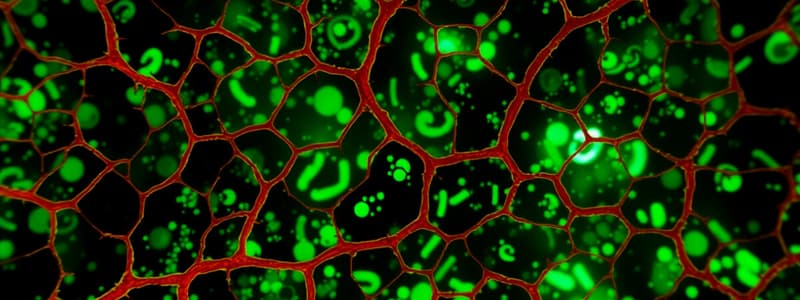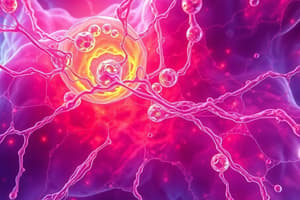Podcast
Questions and Answers
What type of adhesion is primarily responsible for the initial rolling behavior of leukocytes along the endothelial cells?
What type of adhesion is primarily responsible for the initial rolling behavior of leukocytes along the endothelial cells?
- Selective adhesion
- Tight adhesion
- Loose adhesion (correct)
- Permanent adhesion
Which protein is involved in the switch from rolling to tight adhesion in leukocytes?
Which protein is involved in the switch from rolling to tight adhesion in leukocytes?
- iCAM
- P-selectin
- Glycoprotein
- Integrin (correct)
What is the main role of integrins in the process of leukocyte adhesion?
What is the main role of integrins in the process of leukocyte adhesion?
- To enable cell rolling
- To dissolve extracellular matrix
- To prevent apoptosis
- To bind tightly to iCAM (correct)
Which of the following correctly describes glycoproteins?
Which of the following correctly describes glycoproteins?
What initiates the rolling of leukocytes on the endothelium?
What initiates the rolling of leukocytes on the endothelium?
How does the conformation of integrin change during the adhesion process?
How does the conformation of integrin change during the adhesion process?
Which of the following statements about proteoglycans is true?
Which of the following statements about proteoglycans is true?
What is the significance of the regulation of adhesion strength in leukocyte behavior?
What is the significance of the regulation of adhesion strength in leukocyte behavior?
What is the primary role of collagen in the extracellular matrix (ECM)?
What is the primary role of collagen in the extracellular matrix (ECM)?
How do proteoglycans contribute to the function of the ECM?
How do proteoglycans contribute to the function of the ECM?
What characteristic is true about multi-adhesive matrix proteins?
What characteristic is true about multi-adhesive matrix proteins?
Which of the following proteins is an example of a multi-adhesive matrix protein?
Which of the following proteins is an example of a multi-adhesive matrix protein?
What process allows leukocytes to move from blood vessels into tissues during an infection?
What process allows leukocytes to move from blood vessels into tissues during an infection?
How does integrin function relate to the ECM?
How does integrin function relate to the ECM?
Which component primarily provides the gel-like quality necessary for cushioning in the ECM?
Which component primarily provides the gel-like quality necessary for cushioning in the ECM?
What is a consequence of disrupted integrin function on cell adhesion?
What is a consequence of disrupted integrin function on cell adhesion?
Which of the following best describes the composition of connective tissue?
Which of the following best describes the composition of connective tissue?
What role do integrins play in cell adhesion?
What role do integrins play in cell adhesion?
Which tissue type has the least abundance of extracellular matrix?
Which tissue type has the least abundance of extracellular matrix?
What triggers the activation of integrins?
What triggers the activation of integrins?
How does aberrant cell adhesion contribute to metastasis?
How does aberrant cell adhesion contribute to metastasis?
Which major protein category is NOT part of the ECM composition?
Which major protein category is NOT part of the ECM composition?
What is the primary structure of the basal lamina?
What is the primary structure of the basal lamina?
How are integrins involved in focal adhesions?
How are integrins involved in focal adhesions?
What kind of cell-cell interaction does ECM support?
What kind of cell-cell interaction does ECM support?
Which cellular structure is primarily responsible for the activity of integrins?
Which cellular structure is primarily responsible for the activity of integrins?
Proteoglycans are primarily characterized by their:
Proteoglycans are primarily characterized by their:
In healthy tissues, what is the role of cell adhesion?
In healthy tissues, what is the role of cell adhesion?
What is a common feature of metastatic cancer cells?
What is a common feature of metastatic cancer cells?
The extracellular matrix is primarily composed of which types of proteins?
The extracellular matrix is primarily composed of which types of proteins?
Flashcards
Loose Adhesion
Loose Adhesion
Initial weak binding between leukocytes and endothelial cells, allowing cells to roll along blood vessel walls.
Cell Rolling
Cell Rolling
The movement of leukocytes along the endothelial cells in a blood vessel, mediated by loose adhesion.
Glycoproteins
Glycoproteins
Proteins with attached sugar molecules.
Selectins
Selectins
Signup and view all the flashcards
Integrins
Integrins
Signup and view all the flashcards
Tight Adhesion
Tight Adhesion
Signup and view all the flashcards
iCAM
iCAM
Signup and view all the flashcards
Extravasation
Extravasation
Signup and view all the flashcards
Tissue organization
Tissue organization
Signup and view all the flashcards
Extracellular Matrix (ECM)
Extracellular Matrix (ECM)
Signup and view all the flashcards
Epithelial tissue
Epithelial tissue
Signup and view all the flashcards
Connective tissue
Connective tissue
Signup and view all the flashcards
Basal lamina
Basal lamina
Signup and view all the flashcards
Integrins
Integrins
Signup and view all the flashcards
Focal adhesions
Focal adhesions
Signup and view all the flashcards
Hemidesmosomes
Hemidesmosomes
Signup and view all the flashcards
Integrin activation
Integrin activation
Signup and view all the flashcards
Collagens
Collagens
Signup and view all the flashcards
Proteoglycans
Proteoglycans
Signup and view all the flashcards
ECM composition
ECM composition
Signup and view all the flashcards
Extravasation
Extravasation
Signup and view all the flashcards
Metastasis
Metastasis
Signup and view all the flashcards
ECM in metastasis
ECM in metastasis
Signup and view all the flashcards
Proteoglycans in ECM
Proteoglycans in ECM
Signup and view all the flashcards
ECM Component: Collagen
ECM Component: Collagen
Signup and view all the flashcards
ECM Component: Multi-adhesive proteins
ECM Component: Multi-adhesive proteins
Signup and view all the flashcards
Laminin
Laminin
Signup and view all the flashcards
Fibronectin
Fibronectin
Signup and view all the flashcards
ECM (Extracellular Matrix)
ECM (Extracellular Matrix)
Signup and view all the flashcards
Extravasation
Extravasation
Signup and view all the flashcards
Integrins Role in ECM
Integrins Role in ECM
Signup and view all the flashcards
Study Notes
Cell-Cell Interactions Part 2
-
Today's Agenda: Overview of tissue organization and ECM, connecting the cell to ECM (Integrins), ECM composition (three major protein categories), and regulation of cell adhesion (driving extravasation).
-
Cells Organize into Tissues: Cells secrete proteins to form the extracellular matrix (ECM). A tissue is composed of cells and ECM. Four major tissue types: epithelial, connective, muscle, and nervous.
-
Tissue Organization:
- ECM is scarce in epithelial tissue, mostly a thin basal lamina.
- ECM is abundant in connective tissue, where cells are sparse and do not directly contact each other. Cells in connective tissue are often supported by collagen fibers.
-
Connective Tissue ECM Composition:
- Composition is similar to basal lamina but with additional components.
- Three major categories of ECM proteins exist:
- Collagens: Provide structural integrity and mechanical strength. Sheet-forming collagens (like type IV) are in basal lamina; fibrillar collagens are in connective tissue.
- Proteoglycans: Proteins with attached sugars that cushion the ECM and give it a gel-like consistency.
- Multi-adhesive matrix proteins: Proteins that cross-link ECM proteins and bind integrins, connecting the ECM to the cell. Examples include laminin and fibronectin.
-
Integrins: Transmembrane proteins on the cell surface that link the cell to the ECM and other cells. Integrins switch between active and inactive states based on signals.
- Integrins are components of focal adhesions and hemidesmosomes.
- Integrins can bind to other proteins on the cell surface as well as other proteins within the ECM.
-
Basal Lamina: A sheet-like ECM found between epithelial and connective tissue.
- The basal lamina is composed of collagen, proteoglycans, and multi-adhesive matrix proteins.
- Integrins in cells interact with the basal lamina, attaching the cells to the tissue.
-
Structure Differences in Basal Lamina:
- Structure varies slightly based on tissue type,
- In muscle: basal lamina surrounds muscle cells.
- In epithelial tissue: basal lamina forms a sheet-like surface that the epithelial cells rest upon.
-
ECM Components: Collagen in Basal Lamina:
- Collagen IV proteins form a network by associating through their N- and C-terminal globular domains.
- Three collagen IV molecules form a triple helix (subunit).
-
ECM Components: Collagen in Connective Tissue:
- Fibrillar collagens form fibers within connective tissue.
- Collagen subunits associate along their lengths to form fibrils.
- These fibrils assemble into fibers in connective tissue.
- Collagen fibers are extremely strong and support the tissue structurally.
- Collagen secretion occurs outside the cell, and procollagen is processed into collagen in the extracellular matrix.
- Defects in collagen processing can result in hyperflexible skin.
-
ECM Components: Proteoglycans:
- Proteoglycans have GAGs (glycosaminoglycans) attached that can form large aggregates.
- GAGs commonly have a gel-like consistency that resists compression within tissues.
- GAGs are assembled onto proteoglycans in the Golgi.
-
ECM Components: Multi-adhesive Matrix Proteins:
- Multi-adhesive matrix proteins help form the ECM by crosslinking proteins.
- Multi-adhesive matrix proteins bind to other proteins and to integrins, which binds them to the cell.
- Examples: laminin and fibronectin.
- Fibronectin has domains for binding to different ECM components and to integrins, anchoring collagen in tissues to cells.
- Laminin is found within the basal lamina and has binding domains for other ECM proteins and integrins.
-
Regulation of Cell Adhesion in Extravasation:
- Extravasation is how leukocytes (white blood cells) migrate to infection sites.
- Leukocytes initially transiently adhere to blood vessel walls using loose adhesion (selectins binding to glycoproteins along the vessel).
- Cells begin to roll along the blood vessels.
- Upon reaching a signal on site at infection, cells switch to tight adhesion (integrins bind to proteins like ICAM-1) allowing cells to leave the blood vessel and enter the infected tissue.
-
Reminders: Exam 4 review, final assignment, and attendance policies for the upcoming Friday and Monday classes and mandatory attendance.
-
Meme/TikTok Assignment: Submit a meme/TikTok conveying a cell biology concept this week for extra credit.
Studying That Suits You
Use AI to generate personalized quizzes and flashcards to suit your learning preferences.




